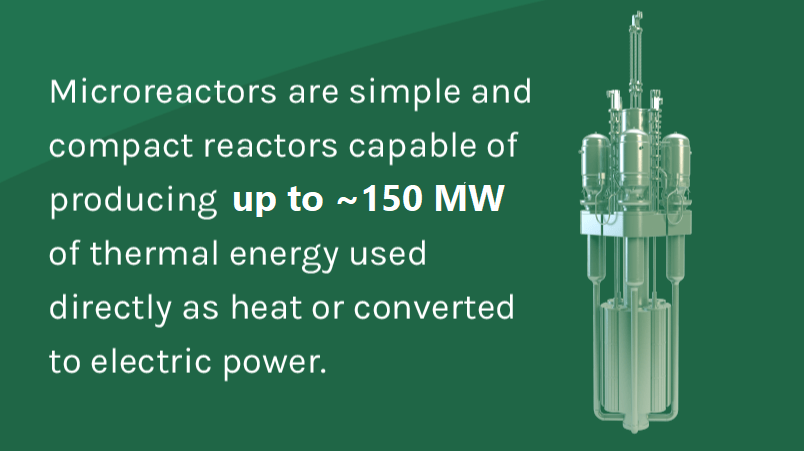What are Microreactors?
Microreactors are a class of very small modular reactors targeted for non-conventional nuclear markets. The U.S. Department of Energy supports a variety of advanced reactor designs, including gas, liquid-metal, molten-salt, and heat-pipe-cooled concepts. In the U.S., microreactor developers are currently focused on designs that could be deployed as early as the mid-2020s.

Key Attributes of Microreactors
Microreactors have key features enabled by their small size that distinguish them from other reactor types mainly large reactors (LWRs) and small modular reactors (SMRs).
- Factory Fabrication. The majority of components of a microreactor are anticipated be fully assembled in a central factory and shipped out to the locations of operation. This allows shifting from large-scale unique construction to repeatable factory construction, thus reducing the marginal cost of production, and helping install the reactor on-site and go operational quickly.
- Transportable. Smaller unit designs can enable multi-model transportation in their fully assembled configuration. Transportation by truck, rail, ship, or perhaps air are envisioned.
- Self-regulating. Simple and responsive design concepts can enable remote and semi-autonomous microreactor operations that may significantly reduce the number of specialized operators required onsite. In addition, microreactors plan to use utilize passive safety systems that can prevent overheating or reactor meltdown.
Benefits of Microreactors
They can be used to generate reliable and affordable electricity for commercial use or for non-electric applications such as process heat for manufacturing. Other benefits include:
- Seamless integration with renewables within microgrids
- Can be used for emergency response to help restore power to areas hit by natural disasters
- A longer core life, operating for up to 10 years without refueling
- Can be quickly removed from sites and exchanged for new ones
Most designs will require fuel with a higher concentration of uranium-235 that’s not currently used in today’s reactors, although some may benefit from use of high-temperature moderating materials that would reduce fuel enrichment requirements while maintaining the small system size.
The U.S. Department of Energy supports a variety of advanced reactor designs, including gas, liquid metal, molten salt and heat pipe-cooled concepts. American microreactor developers are currently focused on gas and heat pipe-cooled designs that could debut as early as the mid-2020s.
U.S. DOE Microreactor Program
The U.S. Department of Energy (DOE) Microreactor Program supports research and development (R&D) of technologies related to the development, demonstration, and deployment of very small, factory fabricated, transportable reactors to provide power and heat for decentralized generation in civilian, industrial and defense energy sectors.


